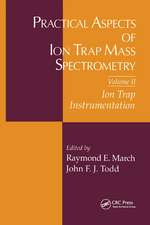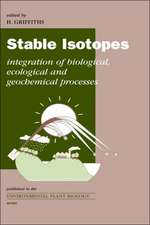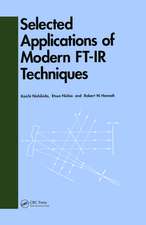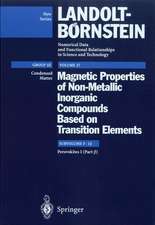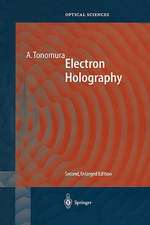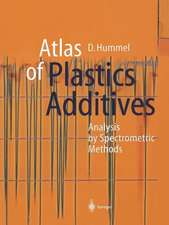Symmetry and Symmetry-Breaking in Semiconductors: Fine Structure of Exciton States: Springer Tracts in Modern Physics, cartea 279
Autor Bernd Hönerlage, Ivan Pelanten Limba Engleză Hardback – 28 sep 2018
Since Hamiltonians have to be invariant under the transformations of the point group, the crystal symmetry determines the multiplet structure of these states in the presence of spin-orbit, crystal-field, or exchange interactions. Symmetry-breaking leads to additional coupling of the states, resulting in shifts and/or splittings of the multiplets. Such interactions may be intrinsic, as in the case of the quasi-particle dispersion, or extrinsic, induced by magnetic, electric, or strain fields. Using a power expansion of the perturbations these interaction terms can be determined in their parameterized form in a unique way. The hierarchic structure of this invariant development allows to estimate the importance of particular symmetry-breaking effects in the Hamiltonian. A number of selected experimental curves are included to illustrate the symmetry-based discussions, which are especially important in optical spectroscopy.
This text is written for graduate students and researchers who want to understand and simulate experimental findings reflecting the fine structure of electronic or excitonic states in crystalline semiconductors.
| Toate formatele și edițiile | Preț | Express |
|---|---|---|
| Paperback (1) | 579.99 lei 39-44 zile | |
| Springer International Publishing – 11 feb 2019 | 579.99 lei 39-44 zile | |
| Hardback (1) | 702.54 lei 6-8 săpt. | |
| Springer International Publishing – 28 sep 2018 | 702.54 lei 6-8 săpt. |
Din seria Springer Tracts in Modern Physics
- 15%
 Preț: 648.42 lei
Preț: 648.42 lei - 18%
 Preț: 887.38 lei
Preț: 887.38 lei - 18%
 Preț: 1127.60 lei
Preț: 1127.60 lei - 20%
 Preț: 814.70 lei
Preț: 814.70 lei - 20%
 Preț: 816.04 lei
Preț: 816.04 lei - 18%
 Preț: 1424.83 lei
Preț: 1424.83 lei - 18%
 Preț: 785.55 lei
Preț: 785.55 lei -
 Preț: 409.63 lei
Preț: 409.63 lei -
 Preț: 428.30 lei
Preț: 428.30 lei -
 Preț: 426.34 lei
Preț: 426.34 lei -
 Preț: 387.38 lei
Preț: 387.38 lei -
 Preț: 387.20 lei
Preț: 387.20 lei -
 Preț: 381.21 lei
Preț: 381.21 lei -
 Preț: 378.71 lei
Preț: 378.71 lei -
 Preț: 382.95 lei
Preț: 382.95 lei -
 Preț: 384.48 lei
Preț: 384.48 lei -
 Preț: 382.36 lei
Preț: 382.36 lei -
 Preț: 387.38 lei
Preț: 387.38 lei -
 Preț: 391.40 lei
Preț: 391.40 lei -
 Preț: 380.63 lei
Preț: 380.63 lei -
 Preț: 386.00 lei
Preț: 386.00 lei - 18%
 Preț: 884.07 lei
Preț: 884.07 lei -
 Preț: 386.00 lei
Preț: 386.00 lei -
 Preț: 385.25 lei
Preț: 385.25 lei -
 Preț: 383.71 lei
Preț: 383.71 lei -
 Preț: 377.95 lei
Preț: 377.95 lei -
 Preț: 377.18 lei
Preț: 377.18 lei -
 Preț: 377.95 lei
Preț: 377.95 lei -
 Preț: 384.70 lei
Preț: 384.70 lei -
 Preț: 381.98 lei
Preț: 381.98 lei -
 Preț: 391.61 lei
Preț: 391.61 lei -
 Preț: 379.68 lei
Preț: 379.68 lei -
 Preț: 384.70 lei
Preț: 384.70 lei -
 Preț: 391.40 lei
Preț: 391.40 lei -
 Preț: 378.92 lei
Preț: 378.92 lei -
 Preț: 380.25 lei
Preț: 380.25 lei -
 Preț: 377.35 lei
Preț: 377.35 lei -
 Preț: 382.57 lei
Preț: 382.57 lei -
 Preț: 384.31 lei
Preț: 384.31 lei -
 Preț: 381.21 lei
Preț: 381.21 lei -
 Preț: 387.96 lei
Preț: 387.96 lei -
 Preț: 381.43 lei
Preț: 381.43 lei -
 Preț: 384.48 lei
Preț: 384.48 lei -
 Preț: 386.22 lei
Preț: 386.22 lei - 18%
 Preț: 1224.99 lei
Preț: 1224.99 lei
Preț: 702.54 lei
Preț vechi: 826.53 lei
-15% Nou
Puncte Express: 1054
Preț estimativ în valută:
134.44€ • 143.75$ • 112.09£
134.44€ • 143.75$ • 112.09£
Carte tipărită la comandă
Livrare economică 17 aprilie-01 mai
Preluare comenzi: 021 569.72.76
Specificații
ISBN-13: 9783319942346
ISBN-10: 3319942344
Pagini: 212
Ilustrații: XV, 240 p. 55 illus.
Dimensiuni: 155 x 235 mm
Greutate: 0.58 kg
Ediția:1st ed. 2018
Editura: Springer International Publishing
Colecția Springer
Seria Springer Tracts in Modern Physics
Locul publicării:Cham, Switzerland
ISBN-10: 3319942344
Pagini: 212
Ilustrații: XV, 240 p. 55 illus.
Dimensiuni: 155 x 235 mm
Greutate: 0.58 kg
Ediția:1st ed. 2018
Editura: Springer International Publishing
Colecția Springer
Seria Springer Tracts in Modern Physics
Locul publicării:Cham, Switzerland
Cuprins
Introduction.- Symmetry-Breaking in Spin-Degenerate Conduction-Bands of Zincblende-Type Crystals.- Symmetry-Breaking Effects in Valence Bands of Zincblende-Type Crystals.- Exciton Ground State in Zincblende-Type Semiconductors.- Pseudo-Spin Development of the Exciton Ground State in Zincblende-Type Semiconductors.- Invariant Expansion and Electron-Band Structure Effects in Wurtzite-Type Semiconductors.- Excitons in Wurtzite-Type Semiconductors.- Light-Matter Interaction and Exciton-Polaritons in Semiconductors.- Appendix.- Index.
Notă biografică
Prof. Dr. Bernd Hönerlage is emeritus at the University of Strasbourg and former senior researcher at the CNRS (France). His research focuses on ultrafast dynamics in bulk semiconductors and nano-objects, especially the non-linear optics and time resolved spectroscopy of bulk semiconductor material and nano-crystals. He has more than 30 years of teaching experience in condensed matter and nano-physics.
Prof. Dr. Ivan Pelant is senior researcher at the Institute of Physics of The Czech Academy of Sciences and Professor of Quantum Optics and Optoelectronics at Charles University, Prague (Czech Republic). His research focuses on optical properties of semiconductors, non-linear optics, nanostructures and nanophotonics.
Prof. Dr. Ivan Pelant is senior researcher at the Institute of Physics of The Czech Academy of Sciences and Professor of Quantum Optics and Optoelectronics at Charles University, Prague (Czech Republic). His research focuses on optical properties of semiconductors, non-linear optics, nanostructures and nanophotonics.
Textul de pe ultima copertă
This book discusses group theory investigations of zincblende and wurtzite semiconductors under symmetry-breaking conditions. The text presents the group theory elements required to develop a multitude of symmetry-breaking problems, giving scientists a fast track to bypass the need for recalculating electronic states. The text is not only a valuable resource for speeding up calculations but also illustrates the construction of effective Hamiltonians for a chosen set of electronic states in crystalline semiconductors.
Since Hamiltonians have to be invariant under the transformations of the point group, the crystal symmetry determines the multiplet structure of these states in the presence of spin-orbit, crystal-field, or exchange interactions. Symmetry-breaking leads to additional coupling of the states, resulting in shifts and/or splittings of the multiplets. Such interactions may be intrinsic, as in the case of the quasi-particle dispersion, or extrinsic, induced by magnetic, electric, or strain fields. Using a power expansion of the perturbations these interaction terms can be determined in their parameterized form in a unique way. The hierarchic structure of this invariant development allows to estimate the importance of particular symmetry-breaking effects in the Hamiltonian. A number of selected experimental curves are included to illustrate the symmetry-based discussions, which are especially important in optical spectroscopy.
This text is written for graduate students and researchers who want to understand and simulate experimental findings reflecting the fine structure of electronic or excitonic states in crystalline semiconductors.
Since Hamiltonians have to be invariant under the transformations of the point group, the crystal symmetry determines the multiplet structure of these states in the presence of spin-orbit, crystal-field, or exchange interactions. Symmetry-breaking leads to additional coupling of the states, resulting in shifts and/or splittings of the multiplets. Such interactions may be intrinsic, as in the case of the quasi-particle dispersion, or extrinsic, induced by magnetic, electric, or strain fields. Using a power expansion of the perturbations these interaction terms can be determined in their parameterized form in a unique way. The hierarchic structure of this invariant development allows to estimate the importance of particular symmetry-breaking effects in the Hamiltonian. A number of selected experimental curves are included to illustrate the symmetry-based discussions, which are especially important in optical spectroscopy.
This text is written for graduate students and researchers who want to understand and simulate experimental findings reflecting the fine structure of electronic or excitonic states in crystalline semiconductors.
Caracteristici
Enables readers to gain detailed insight into creating effective Hamiltonians for semiconductors Provides a theoretical framework for Zincblende- and for Wurtzite-type semiconductors Gathers the group theory elements required to develop and calculate numerous symmetry-breaking problems in semiconductors Enables readers to estimate the importance of particular symmetry-breaking effects in semiconductors


